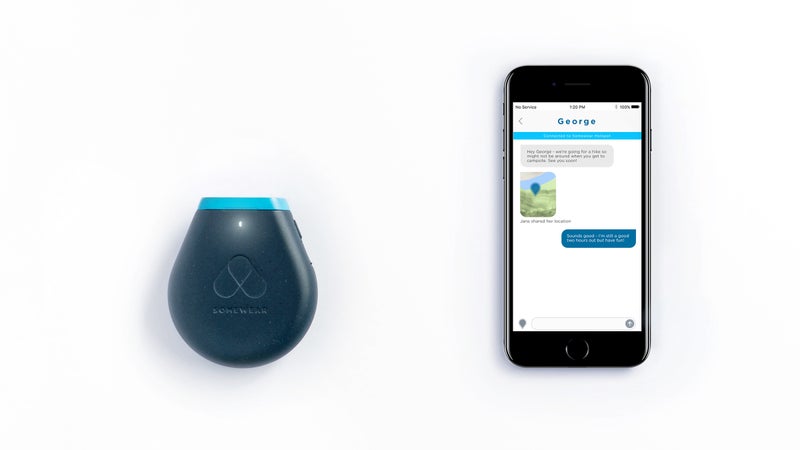A group of former Silicon Valley tech developers are trying to create the ultimate satellite communication device. The Somewear Global Hot Spot, which launched on Kickstarter earlier this month, connects to an iPhone or Android phone via Bluetooth, turning it into a two-way satellite communication tool.
By way of the Iridium satellite network, the Global Hot Spot has a host of features for staying connected in the backcountry, all in a thin, three-inch disk. Through an app, users will be able to send messages to regular phone numbers and email addresses, which means texting with friends, family, and even rescuers. Users will also be able to connect to the Somewear servers, which use your device’s GPS coordinates to offer location-specific weather updates. Of course, the Global Hot Spot also has an SOS button that sends a geotagged rescue call to the nearest search and rescue operation and the ability to drop automatic GPS pins at predetermined intervals, so folks can track you from home without you having to remember to send them a message.

We have yet to try the Global Hot Spot for ourselves, but on paper the device seems to fill a fundamental gap in the satellite communications market. It’s not doing anything other tools don’t already do; it’s just doing it in a lighter, more user-friendly way. For years, customers had two choices aside from a satellite phone: the Spot Gen 3—which is small and light but limited to one-way communication—and the Garmin InReach, which has two-way messaging and the ability to connect to a phone but in a bigger, heavier package. Both have SOS functions. There’s also the GoTenna Mesh, which works on radio frequencies, rather than satellites. The Mesh requires you to be within a few miles of other Mesh users to send a message, rendering it useless if you’re in a remote place far from other Mesh users trying to send a message to someone miles away.
The Somewear fits between the Spot and the InReach. It’s roughly the same size as the Spot but lighter, weighing in at three ounces, and it has all the functionality of the InReach. “Outdoor technology products have always been designed to be rugged, and user experience often takes a back seat,” says James Kubik, president and co-founder of Somewear. “We’ve done a ton of user research and found that with InReach and Spot, this leads to people giving up and leaving these devices at home, where they’re not helping anyone stay safe.” At $450, the Global Hot Spot will be more expensive than both the InReach and the Spot. Month-to-month satellite subscriptions will cost $15 (20 messages per month), $25 (75 messages per month), or $50 (unlimited messages). For comparison, the Spot Gen 3 basic service plan costs $20 per month with unlimited messages (users can upgrade to two-minute pin tracking), while Garmin’s monthly plans cost $15, $35, $65, and $100 and range from ten messages per month with a charge per GPS pin to unlimited messages and GPS pins.
Big-mountain snowboarder Jeremy Jones has spent the past winter testing the new Hot Spot. He and Kubik met at a movie premier in California, and Kubik pulled Jones aside to show him a prototype. “I was immediately like, ‘Yes! I need this device every day,’” Jones says. He began beta testing, and almost immediately the Global Hot Spot became his go-to satellite comms device because of how lightweight it is relative to its functionality.
“It’s like my first-aid kit,” Jones says. “It’s not something I’m looking to use all the time.” The Somewear device is light enough for Jones to shove in the bottom of his pack but allows him the two-way communication he needs to talk to rescuers or just let his wife know he’s safe.
With 15 days left in its Kickstarter campaign, Somewear Labs has accrued nearly double its $50,000 funding goal—an indication, at the very least, that there is a market for this kind of lightweight, user-friendly satellite safety device. (The Somewear is available for presale at a $150 discount, with 10 percent off the first six months of a subscription.) Will it live up to the hype? We’ll be able to tell in a few months, when we get to put one to the test.

